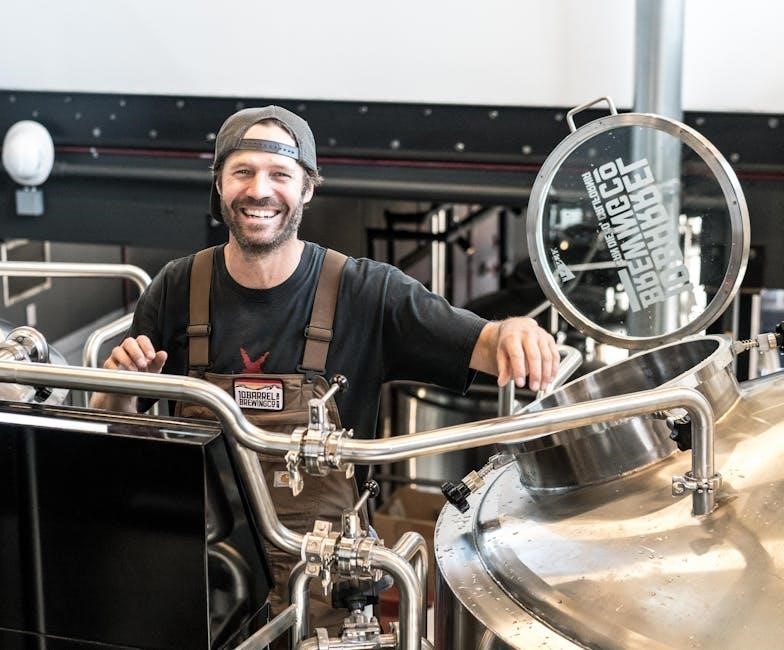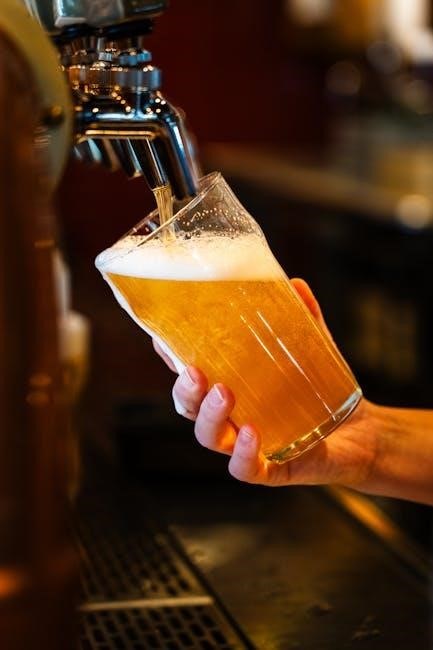Beer is a timeless, versatile beverage crafted from malted grains, hops, water, and yeast․ Its rich history, cultural significance, and diverse styles make it a global phenomenon, offering endless enjoyment and exploration for enthusiasts of all levels․
1․1 What is Beer?
Beer is a fermented alcoholic beverage made primarily from malted grains, hops, water, and yeast․ The brewing process involves malting, milling, mashing, boiling, and fermentation, resulting in a diverse range of flavors and styles․ With alcohol content typically between 4-12%, beer varies widely in color, aroma, and taste, from crisp lagers to robust stouts․ It is enjoyed globally, offering countless options for every palate, whether hoppy, malty, fruity, or bitter․ Beer’s versatility makes it a popular choice for both casual enjoyment and sophisticated pairings․
1․2 Brief History of Beer
Beer’s origins trace back to ancient civilizations around 6,000 years ago, with evidence of brewing found in Mesopotamia, Egypt, and China․ Early beers were fermented from barley and emmer wheat, often cloudy and thick, serving as a safer alternative to water․ The process evolved through the ages, with monasteries preserving brewing techniques during the Middle Ages․ Hops were introduced in the 16th century, revolutionizing flavor and preservation․ Over centuries, beer diversified into countless styles, shaped by regional ingredients and cultural practices, becoming a beloved global drink celebrated for its rich history and continuous innovation․
1․3 Cultural Significance of Beer
Beer holds a profound cultural significance worldwide, often at the heart of traditions, celebrations, and social gatherings․ From ancient rituals in Mesopotamia to modern-day festivals like Oktoberfest, beer has historically united communities․ Its role in cuisine, rituals, and storytelling reflects its deep-rooted place in human culture․ Local breweries and pubs often serve as community hubs, fostering camaraderie and cultural exchange․ Beer’s diversity mirrors global traditions, with each region offering unique styles and brewing methods․ This beloved drink continues to inspire festivals, art, and cuisine, cementing its status as a cultural cornerstone across generations and borders․
Beer Brewing Process
Beer brewing involves malting, mashing, boiling, fermentation, and conditioning․ Malted grains are steeped, mashed, and boiled with hops, then fermented with yeast, creating a diverse range of flavors and styles․
2․1 Ingredients in Beer
Beer is traditionally crafted from four core ingredients: malted grains, hops, water, and yeast․ Malted grains, typically barley, provide fermentable sugars, while hops add bitterness, flavor, and aroma․ Water quality significantly impacts the beer’s taste, and yeast ferments the sugars into alcohol․ Brewers may also experiment with additional ingredients like fruits, herbs, or spices to create unique flavors, contributing to the vast diversity in beer styles and profiles․ These foundational components work harmoniously to produce the wide variety of beers enjoyed globally․
2․2 Steps in Beer Production
Beer production involves several key steps․ First, malting converts barley grains into malt, activating enzymes․ Milling crushes the malt into a coarse powder․ Mashing mixes the milled grains with hot water to extract sugars․ Boiling the mash with hops adds bitterness and flavor․ Fermentation follows, where yeast converts sugars into alcohol․ After fermentation, conditioning allows the beer to mature․ Finally, the beer is filtered, carbonated, and packaged․ These steps ensure a consistent and high-quality final product, with variations depending on the brewery and desired beer style․
2․3 Fermentation and Aging
Fermentation is where yeast converts sugars into alcohol, typically lasting 7-14 days for ales and longer for lagers․ After fermentation, beer undergoes conditioning or aging to develop its flavor and clarity․ During this process, flavors mature, and residual yeast or sediment settles․ Aging can occur in tanks, barrels, or bottles, with some beers benefiting from extended periods to enhance complexity․ Proper temperature control is crucial to ensure the desired character․ This step is vital for achieving the balance and depth that define high-quality beers, whether they are crisp lagers or robust ales․

Types of Beer
Beer is categorized into diverse styles, including ales, lagers, stouts, and porters․ Each type offers unique flavors, from crisp lagers to robust stouts, catering to varied palates worldwide․
3․1 Ale vs․ Lager
Ales and lagers are the two primary beer categories, differing in fermentation methods․ Ales use top-fermenting yeast at warmer temperatures, resulting in fruity, complex flavors․ Lagers use bottom-fermenting yeast at cooler temperatures, producing crisp, smooth profiles․ Ales typically finish fermentation quicker, while lagers undergo longer aging for clarity and balance․ Popular ales include IPAs and porters, while lagers range from Pilsners to bocks․ Each style offers unique characteristics, catering to diverse preferences․ Understanding these differences helps beer enthusiasts appreciate the craftsmanship behind each brew․
3․2 Popular Beer Styles
Popular beer styles vary widely, offering diverse flavor profiles for every palate․ IPA (India Pale Ale) is known for its hoppy bitterness and citrus notes․ Lager, including Pilsner and Helles, is crisp and refreshing․ Stout, famous for its dark, roasted character, ranges from dry to sweet․ Wheat beers, like Hefeweizen, are light and fruity․ Sour beers provide tart, funky experiences․ These styles, among many others, cater to different tastes and occasions, making beer a versatile and endlessly enjoyable drink․ Each style reflects brewing traditions and innovation, ensuring there’s always something new to explore․
3․4 Craft Beer vs․ Traditional Beer
Craft beer and traditional beer differ in production methods and philosophy․ Craft beer emphasizes uniqueness, innovation, and high-quality ingredients, often focusing on small-batch production and experimental flavors․ Traditional beer, by contrast, adheres to longstanding brewing techniques and recipes, prioritizing consistency and heritage․ While craft beer often highlights regional or creative twists, traditional beer leans on established styles and time-honored practices․ Both cater to distinct audiences, with craft appealing to adventurous drinkers and traditional attracting those who appreciate classic flavors and brewing legacies․ This duality enriches the beer world, offering something for every taste and preference․

Beer Tasting and Flavor Profiles
Beer tasting involves analyzing appearance, aroma, and flavor, revealing a spectrum of profiles from crisp and hoppy to rich and malty, offering endless sensory experiences․
4․1 Sensory Characteristics of Beer
Beer’s sensory characteristics include appearance, aroma, taste, and mouthfeel․ Appearance varies from pale golden to deep brown, often with a frothy head․ Aroma ranges from floral and hoppy to malty and roasted․ Taste profiles span sweet, bitter, fruity, and earthy notes, while mouthfeel can be crisp, smooth, or creamy․ These elements combine to create a unique experience, with factors like color, clarity, and carbonation enhancing perception․ Understanding these traits helps in identifying styles and appreciating the craftsmanship behind each brew, making beer tasting a journey of discovery and delight for enthusiasts worldwide․
4․2 How to Taste Beer
To taste beer effectively, start by evaluating its appearance, noting color, clarity, and head retention․ Next, swirl the beer to release its aroma, identifying floral, hoppy, or malty notes․ Take a small sip, letting the beer coat your palate to assess sweetness, bitterness, and body․ Pay attention to mouthfeel—whether it’s crisp, creamy, or robust․ Finally, note the finish, describing if it’s clean, lingering, or balanced․ This systematic approach enhances your appreciation of beer’s complexity and helps identify flavor profiles, making each tasting experience more engaging and educational for both newcomers and seasoned enthusiasts․
4․3 Common Flavor Profiles
Beers exhibit a wide range of flavor profiles, from hoppy bitterness and floral notes to rich maltiness and fruity undertones․ Common profiles include citrusy IPAs, toasty Amber Ales, and roasty Stouts․ Each style highlights distinct characteristics, such as the spice of Belgian Tripels or the tartness of Sours․ Understanding these profiles helps enthusiasts identify preferences and explore new brews․ Whether it’s the crispness of a Lager or the warmth of a Barley Wine, flavor profiles guide drinkers through the diverse world of beer, offering a sensory journey that aligns with personal tastes and occasions, enriching the overall experience․

Beer and Food Pairing
Beer and food pairing enhances dining experiences by harmonizing flavors, with brews complementing dishes through contrasting or similar taste profiles, cutting richness, and amplifying aromas for balanced delight․
5․1 Basic Principles of Pairing
Beer and food pairing relies on balancing flavors, textures, and intensities․ Complementary pairing matches similar flavor profiles, while contrasting pairing uses opposites to cut richness or enhance brightness․ Consider the beer’s bitterness, sweetness, and body alongside the dish’s components․ Matching intensity ensures neither overpowering the other․ For example, crisp lagers pair well with spicy or fatty foods, while robust stouts complement rich desserts․ Aroma and mouthfeel also play roles, as hoppy beers can elevate herbal notes in dishes․ The goal is harmony, creating a balanced and enjoyable culinary experience that highlights both the beer and the food․
5․2 Popular Beer and Food Combinations
Classic pairings include crisp lagers with seafood, hoppy IPAs with spicy dishes, and rich stouts with chocolate desserts․ Wheat beers complement lighter fare like salads, while amber ales enhance roasted meats․ Pilsners cut through fatty foods like burgers, and sour beers brighten acidic dishes such as citrus-based recipes․ These combinations enhance flavors, creating a harmonious dining experience․ Experimenting with these pairings allows for endless discovery, making beer a versatile companion for any meal․
5․3 Pairing Beer with Specific Cuisines
Beer pairs exceptionally well with diverse global cuisines․ For Mexican dishes like tacos or ceviche, crisp lagers or zesty wheat beers complement the vibrant flavors․ German cuisine, such as sausages or schnitzel, is perfectly matched with malty lagers or wheat beers․ Asian dishes, particularly those with soy, ginger, or chili, find balance with light pilsners or hoppy IPAs․ Italian cuisine, including pasta or pizza, pairs well with earthy ambers or fruit-forward ales․ These combinations highlight how beer can enhance the unique characteristics of any meal, making it a versatile partner for global flavors․

Beer Glassware
Beer glassware enhances aroma, flavor, and overall enjoyment․ Different shapes and designs are tailored for specific beer styles, ensuring optimal sensory experience and appreciation of the brew․
6․1 Importance of Glassware
The right glassware significantly enhances the beer-drinking experience․ Properly shaped glasses preserve carbonation, release aromatic compounds, and showcase the beer’s color and clarity․ This ensures the full flavor and aroma are appreciated, making glassware essential for both casual drinkers and connoisseurs․ Different styles, like pilsners or Belgian ales, benefit from specific designs, optimizing their unique characteristics․ Investing in quality glassware elevates the enjoyment of beer, highlighting its craftsmanship and complexity․ It’s a simple yet impactful way to enhance every sip and truly respect the brewer’s artistry․
6․2 Common Beer Glass Types
Several glass types are designed to enhance specific beer styles․ The Pilsner glass, tall and narrow, preserves carbonation and clarity for crisp lagers․ The Weizen glass, wider and curved, captures the aroma and foam of wheat beers․ Tulip glasses, with their flared rims, amplify the aroma of hoppy or Belgian ales․ Snifter glasses, shaped like tulips, are ideal for sipping strong, complex beers․ Mugs, with their sturdy handles, are perfect for hearty, malty brews․ Each design complements the unique characteristics of its intended beer, ensuring an optimal sensory experience for drinkers of all preferences․
6․3 How to Choose the Right Glass
Choosing the right glass for your beer enhances its flavor and aroma․ Match the glass to the beer style, as different shapes and sizes are designed to highlight specific characteristics․ For hoppy or aromatic beers, opt for a tulip or snifter to capture the bouquet․ Pilsners and lagers shine in tall, narrow glasses that preserve carbonation․ Wheat beers benefit from curved weizen glasses that showcase their cloudy appearance․ Consider the beer’s mouthfeel and intensity when selecting․ Personal preference also plays a role, but aligning the glass with the beer’s style ensures an optimal drinking experience․ Use beer style guides for tailored recommendations․

Storing and Serving Beer
Store beer in a cool, dark place to preserve flavor and aroma․ Serve at optimal temperatures to enhance taste․ Proper ventilation ensures freshness and longevity․
7․1 Proper Storage Conditions
Proper beer storage is essential to preserve flavor and aroma․ Store beer in a cool, dark place with consistent temperatures between 40-50°F (4-10°C)․ Avoid direct sunlight and heat sources, as they can cause skunking․ Use airtight containers or bottles to prevent oxidation․ Maintain humidity levels around 50-70% to prevent cork dryness in bottled beers․ Keep beer upright to avoid contact between the cork and liquid, reducing contamination risks․ These conditions ensure optimal freshness and longevity, maintaining the beer’s intended taste and character․
7․2 Serving Temperatures
Serving temperature significantly impacts beer flavor and enjoyment․ Most beers are best served between 40-55°F (4-13°C), with lagers typically cooler (40-50°F) and ales slightly warmer (50-55°F)․ Stronger, darker beers like stouts or barley wines benefit from warmer temperatures (55-60°F), enhancing their complex flavors․ Over-chilling suppresses aroma and taste, while serving too warm can accentuate undesired traits․ Always check the brewer’s recommendations for specific styles; A consistent refrigerator temperature ensures optimal freshness and flavor profile, making every sip a perfect experience for beer enthusiasts․
7․3 Shelf Life of Beer
Beer shelf life varies depending on storage conditions and style․ Properly stored in a cool, dark place, most beers last 6-12 months․ Hoppy beers like IPAs are best consumed fresh, as hops fade quickly․ Stouts, porters, and barley wines age well, improving over years․ Light and heat are enemies, causing skunking and off-flavors․ Refrigerated beer slows aging but risks oxidation if left too long․ Always check “best by” dates and brewer guidelines for specific styles․ Freshness ensures optimal flavor, so drink within recommended timelines for the best experience․

Health Considerations
Beer can be part of a balanced diet but contains calories and alcohol; Moderation is key for health benefits, while non-alcoholic options provide alternatives for responsible consumption․
8․1 Calories and Nutrition in Beer
Beer calories vary widely, depending on alcohol content and ingredients․ A typical serving ranges from 150 to 300 calories, with higher ABV beers generally containing more․ Beer is primarily composed of water, carbohydrates, and some protein, with minimal fat․ It also contains fiber, vitamins like B12 and B6, and minerals such as potassium and magnesium․ Hops contribute antioxidants, while yeast adds B vitamins․ Non-alcoholic beers often have fewer calories but similar nutritional profiles․ Moderation is key to enjoying beer as part of a balanced diet․
8․2 Alcohol Content and Responsibility
Beer typically ranges in alcohol content from 4% to 12% ABV, with craft beers often falling on the higher end․ Responsible consumption is crucial, as excessive alcohol can lead to health risks․ Legal drinking ages and moderation are emphasized to ensure safety․ Drinking and driving is strongly discouraged, with many campaigns promoting designated drivers; Education about alcohol limits and effects is vital for enjoyable and responsible beer experiences, fostering a culture of mindfulness and respect for individual tolerance levels․ Always prioritize health and safety when consuming beer․
8․3 Non-Alcoholic Beer Options
Non-alcoholic beer offers a flavorful alternative for those who prefer minimal or no alcohol․ Modern brewing techniques preserve the taste and aroma of traditional beer while keeping ABV below 0․5%․ These beers are crafted using special yeasts or vacuum distillation to halt fermentation early․ They cater to health-conscious drinkers, pregnant individuals, and those abstaining from alcohol․ With growing demand, breweries now produce high-quality non-alcoholic versions of popular styles like IPAs and stouts․ These options ensure everyone can enjoy the taste of beer responsibly, making them a great choice for any occasion․

Beer Culture and Festivals
Beer culture celebrates global traditions, festivals, and community․ Events like Oktoberfest showcase rich heritage, while local brews highlight unique flavors, uniting people worldwide in shared enjoyment and camaraderie․
9․1 Famous Beer Festivals
Famous beer festivals celebrate brews from around the globe, showcasing traditions and craftsmanship․ Oktoberfest in Munich, Germany, is the world’s largest, offering authentic Bavarian beers and culture․ The Great American Beer Festival in Colorado highlights U․S․ craft brews, while Belgium’s Zythos Bier Festival features its renowned Trappist and Lambic beers․ The Pilsner Fest in the Czech Republic honors the birthplace of Pilsner lager․ These events attract millions, blending history, live music, and local cuisine with endless beer varieties, creating unforgettable experiences for enthusiasts and casual drinkers alike․
9․2 Beer Culture Around the World
Beer culture varies wildly across the globe, reflecting local traditions and tastes․ In Belgium, Trappist beers are revered for their monastic heritage, while Germany’s Reinheitsgebot ensures brewing purity․ The Czech Republic boasts the highest per-capita beer consumption, with Pilsner lagers dominating․ In the U․S․, craft beer has sparked a vibrant, innovative scene․ Local beer experts in Prague guide visitors to hidden pubs, and festivals like Oktoberfest celebrate Bavarian traditions․ Each region’s unique brewing methods and preferences highlight beer’s role in shaping cultural identity and fostering community, making it a unifying yet diverse global beverage․
9․3 Home Brewing Communities
Home brewing communities are vibrant groups of enthusiasts who share knowledge, recipes, and techniques․ These communities thrive online and in local meetups, fostering collaboration and innovation․ Many host competitions and workshops, encouraging brewers to experiment and refine their craft․ From beginners to seasoned experts, these networks provide support and inspiration․ They also celebrate the creativity and diversity of homebrewing, preserving traditional methods while embracing modern twists․ Home brewing communities are a testament to the passion and camaraderie that define beer culture, ensuring the art of brewing remains accessible and dynamic for future generations․

Beer Industry and Trends
The beer industry is evolving, with trends like sustainability, craft beer innovation, and rising demand for non-alcoholic options shaping its future․ Digital tools now enhance production and distribution․
10․1 Craft Beer Revolution
The craft beer revolution has transformed the industry, emphasizing quality, creativity, and local production․ Small breweries now experiment with unique ingredients and techniques, offering diverse flavors that cater to a growing audience․ This movement has fostered innovation, challenged traditional brewing methods, and reshaped consumer preferences, leading to a vibrant and dynamic beer culture worldwide․
10․2 Sustainability in Brewing
Sustainability in brewing focuses on eco-friendly practices to reduce environmental impact․ Breweries adopt energy-efficient equipment, water conservation methods, and waste reduction programs․ Many now use solar power, organic ingredients, and recyclable packaging․ These efforts not only benefit the planet but also enhance brand reputation and consumer trust․ Sustainable brewing prioritizes ethical sourcing and minimizing carbon footprints, ensuring a greener future for the industry while maintaining high-quality beer production․ This trend reflects a growing commitment to environmental responsibility and long-term viability in the brewing sector․
10․3 Future Trends in Beer
The future of beer is shaped by innovation, consumer preferences, and sustainability․ Non-alcoholic beer is gaining popularity, driven by health-conscious drinkers․ Low-calorie, gluten-free, and functional beers are expected to rise․ Technology like AI in brewing will optimize flavors and efficiency․ Eco-friendly packaging and circular economy practices are becoming standard․ Hard seltzers and flavored beers will continue to grow, appealing to a broader audience․ Craft beer will expand globally, with experimentation in unique ingredients․ Online platforms will enhance direct-to-consumer sales, reshaping the market․ These trends reflect a dynamic industry adapting to modern tastes and environmental demands while preserving beer’s rich tradition and creativity․

Resources for Beer Enthusiasts
Explore comprehensive guides, apps, and books to deepen your beer knowledge․ Discover style guides, tasting sheets, and expert recommendations to enhance your journey as a beer enthusiast․
11․1 Beer Style Guides
Beer style guides are essential tools for understanding the diverse world of beer․ From the BJCP (Beer Judge Certification Program) guidelines to CraftBeer․com’s detailed breakdowns, these resources provide in-depth descriptions of beer styles, including flavor profiles, aroma characteristics, and historical contexts․ Whether you’re a casual drinker or a seasoned connoisseur, these guides offer a structured approach to exploring beer․ They cover popular styles like IPA, Stout, and Sour, as well as lesser-known varieties, helping enthusiasts navigate the complexities of beer appreciation and expand their palates with confidence․
11․2 Beer Tasting Sheets
Beer tasting sheets are invaluable tools for documenting and analyzing beer experiences․ These structured forms typically include sections for appearance, aroma, flavor, mouthfeel, and overall impression, allowing tasters to systematically evaluate a beer’s characteristics․ Many resources, like the BJCP (Beer Judge Certification Program) tasting sheets, offer detailed templates to guide enthusiasts․ Whether for personal enjoyment or professional reviews, these sheets enhance appreciation by encouraging careful observation and note-taking․ They are especially useful for tracking progress in developing a refined palate and exploring the vast diversity of beer styles available worldwide․
11․3 Recommended Reading
For deeper insights into the world of beer, explore essential books like The Good Beer Guide and World Beer Guide, offering comprehensive overviews of styles, breweries, and trends․ Pocket Beer Guide is perfect for quick reference, while online resources like CraftBeer․com’s Beer Styles Study Guide provide detailed methodology for understanding craft beers․ The BJCP (Beer Judge Certification Program) Study Guide is a must for aspiring beer judges, covering evaluation techniques and style parameters․ These resources cater to both novices and experts, enriching your journey through the diverse and evolving world of beer․
Beer is a journey of discovery, blending history, culture, and flavor․ This guide has explored its origins, production, diverse styles, and pairing possibilities, offering insights for every enthusiast․ From traditional brews to craft innovations, beer’s evolution continues to captivate․ Whether you’re a casual drinker or a connoisseur, resources like The Good Beer Guide, online style guides, and tasting tools invite deeper exploration․ Cheers to the endless adventures in the world of beer!